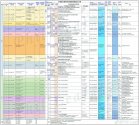I really like the fact that China's space program has basically non-stop milestones lined up from 2021-2023, almost on a monthly basis. Assembling a multi-module space station as well as next generation cargo and manned vehicles, the space telescope, chang'e 7 swarm mini-landers, and asteroid sample-return mission are all well underway and past the point of return. I'm hoping they firm up the following missions because otherwise the calendars start looking empty around 2024-2025.
- Jupiter exploration mission, with possible lander on one of the moons
- Mars generation 2 rover (call them curiosity-class), possibly powered by RTG and integrated with a broader sample return to earth
- Venus probe mission, possibly with lander or a blimp to float in the atmosphere
- Deep space probe to neptune or uranus, both to test out new propulsion technologies and also provide better data on outer planets, since they have only been flybys in late 70s and 80s. Bonus if microsatellites could also be sent to map out some of the moons.
What I do not want to see:
- manned missions to luna; very expensive and questionable scientific value, let the americans be the guinea pigs and flag wavers
- manned missions to mars; even more expensive but better scientific value, again let the americans be the guinea pigs and bankrupt themselves, maybe china gets to rescue a mark watson too...
I do believe however that China should "race" Americans to mars from an unmanned sample return. Sample return from Mars would likely be a monumental effort, involving multiple curiosity-class rovers gathering various rock samples, with multiple retrieval rovers, Martian launch ascenders, mars orbiters and earth returners. This would be many times the magnitude and complexity of Tianwen-1 and Chang'e 5 and also necessitate launches on a LM-9 class rocket (or a bunch of LM-5s, but that would be wasteful). China could create a stretch goal like sample return by 2030 (or maybe just starting the return from Mars by 2030, since it takes years to make the journey), and then mobilize Chinese society and students like the Americans in the 60s.
If we can get some Russian or European sensors on these probes too, the better. Its time for china to create its own space alliance.


